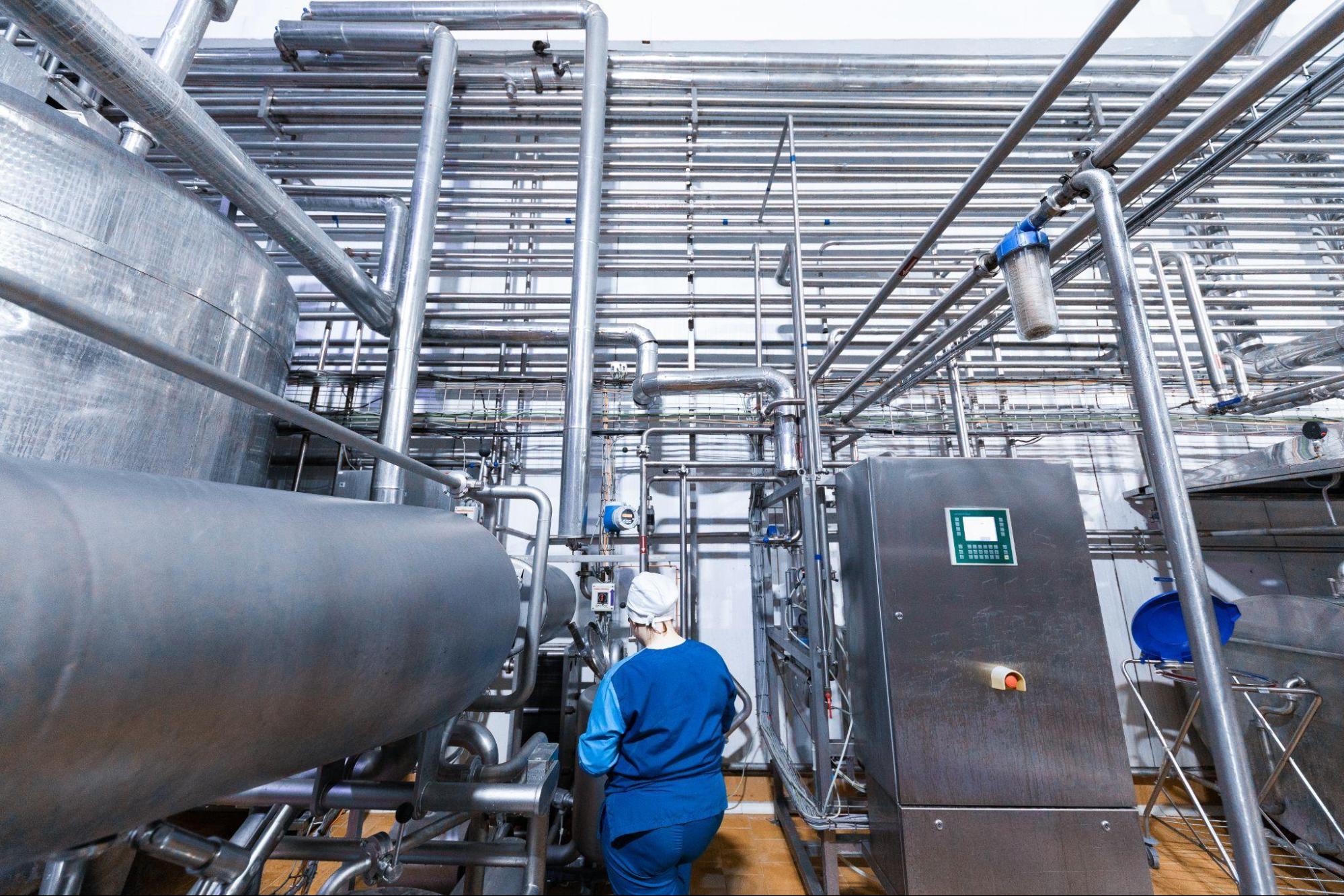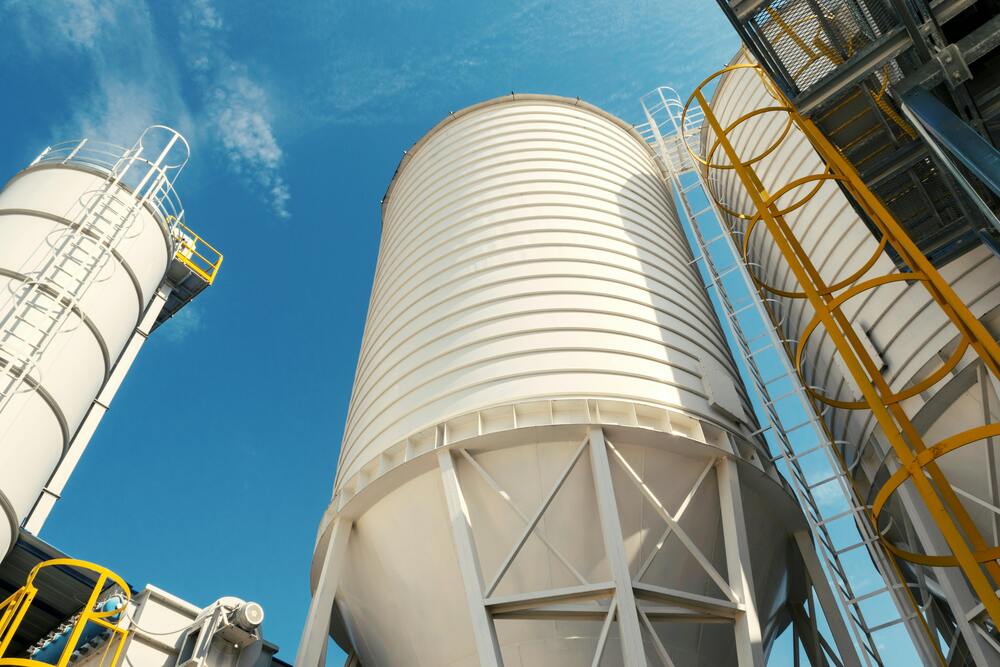Pneumatic conveying systems are essential for transporting dry bulk materials like powders, granules, and pellets through pipelines using air pressure or vacuum. These systems are widely used in industries such as food processing and manufacturing due to their ability to move materials safely, cleanly, and efficiently.
Pneumatic systems are typically classified into two main categories: dense phase and dilute or lean phase conveying. For manufacturers, understanding the key differences between dense phase vs dilute phase is essential for selecting the right system that aligns with your material characteristics, production needs, and overall operational goals.
Dilute Phase / Lean Phase Pneumatic Conveying System
Dilute phase pneumatic conveying involves transporting bulk materials using a continuous stream of air moving at high velocity and low pressure. In this system, the airflow is fast enough to keep particles suspended throughout the pipeline, allowing the material to flow freely and quickly from one point to another.
Advantages of Dilute Phase Pneumatic Conveying
Some of the benefits of dilute phase pneumatic conveying include:
- Enables rapid material transfer
- Lower initial setup costs
- Straightforward system design and operation
- Compatible with a broad spectrum of materials
- Typically compact and can save space
Disadvantages of Dilute Phase Pneumatic Conveying
While it comes with various benefits, this type of pneumatic conveying system also has its limitations. These include:
- Risk of product damage due to intense air speed
- Material segregation can occur during conveying
- Typically requires higher energy input for operation
Dense Phase Pneumatic Conveying System
In dense phase pneumatic conveying, materials are pushed through the pipeline at a much slower speed using high-pressure air. Instead of being suspended, the material moves in concentrated masses (slugs or plugs), making this method particularly effective for fragile or abrasive substances that require gentle handling.
Advantages of Dense Phase Pneumatic Conveying
The benefits of using a dense phase pneumatic conveying system include:
- Minimises product wear and breakage
- Preserves material consistency with less separation
- Generally more energy-efficient for heavy or bulk loads
- Well-suited for extended conveying distances
Disadvantages of Dense Phase Pneumatic Conveying
Some of its potential drawbacks are the following:
- Requires a higher upfront investment
- Installation and system controls are more complex
- Not suitable for all material types
- May demand more space due to added equipment
Comparison of Dense Phase vs Dilute Phase Pneumatic Conveying
Understanding the technical aspects of dilute phase vs dense phase pneumatic conveying helps identify the best fit for your application. These are some of the unique features of each:
System Operating Principles
The fundamental difference between the two systems lies in how they move material through the pipeline.
- Dilute Phase Conveying: These systems transport materials using a high-velocity stream of air, typically at velocities ranging from 18 to 35 m/s. The material remains suspended in the airstream, allowing continuous flow through the pipeline.
- Dense Phase Conveying: Dense phase systems, on the other hand, operate at lower velocities, ranging from 3 to 14 m/s, and utilise higher pressure to propel materials in slugs or plugs. Rather than keeping particles airborne, the bulk material travels in packets, minimising suspension and reducing particle damage.
Material Handling & Behaviour
Material properties significantly influence which conveying system is best suited for the application.
- Dilute Phase Conveying: In dilute phase systems, materials are suspended in a continuous airstream at high velocities. This is better suited for low-density materials, which are lightweight and occupy more volume, as the fast-moving air keeps particles in motion but can lead to segregation or breakage. Typically, it is used for powder handling systems, helping transport materials like milk powder and sugar, among others.
- Dense Phase Conveying: Dense phase systems transport materials in slugs or plugs at low velocities, offering a gentler flow. This method is preferred for abrasive and fragile materials, as the slower movement minimises the risk of wear or damage to both the material and conveying line. The most common materials it transports include coal, cement, and ceramic, among others.
Air Pressure & Energy Requirements
These systems differ greatly in how they utilise air and energy to move materials.
- Dilute Phase Conveying: These systems operate using a large volume of air at relatively low pressure, but they are less energy-efficient overall. These systems typically consume 2 to 2.5 times more power than dense phase systems, making them more costly to operate in the long term, especially in high-throughput settings.
- Dense Phase Conveying: In contrast, dense phase systems use higher air pressure but require significantly less air volume, resulting in greater energy efficiency. On average, dense phase systems consume 40% to 50% less power than dilute (or lean phase) systems, making them a more economical choice for transporting large quantities of bulk material over time.
Equipment Design and Maintenance
Maintenance needs are influenced by both system complexity and how materials are conveyed.
- Dilute Phase Conveying: While simpler in design, dilute phase conveying may require more frequent maintenance depending on the material being conveyed. The high-velocity airflow in these systems can cause increased wear and tear on piping and other components, especially when handling abrasive materials. Common maintenance tasks include cleaning, replacing worn piping parts, replacing wear components, and monitoring air pressure and flow rates to ensure consistent performance.
- Dense Phase Conveying: These systems feature a more complex design and involve additional moving parts, which can result in higher maintenance demands. Maintenance tasks typically include periodic cleaning, inspection, and replacement of valves, piping inspection, replacement of wear components, inspection of electrical components, and ongoing monitoring of system pressure and flow rates. While dense phase systems offer better protection against particle degradation, their operational complexity requires more thorough and scheduled maintenance procedures.
System Cost Implications
Initial investment and long-term operational costs vary notably between the two systems.
- Dilute Phase Conveying: The initial capital cost of a dilute (or lean) phase system is typically lower than that of a dense phase system. However, the operating costs can be significantly higher, especially when conveying heavy or abrasive materials like sand, due to the greater power consumption required to maintain high air velocities.
- Dense Phase Conveying: While the capital investment for a dense phase system is generally higher, it offers notable savings in operating costs over time. Dense phase systems are more energy-efficient, and their lower air velocity reduces wear and tear, leading to reduced maintenance expenses in the long run.
A Step-by-Step Guide on How to Choose Between Lean Phase Conveying vs Dense Phase Conveying
Choosing the right pneumatic conveying system involves more than comparing initial costs. It requires a close examination of your material characteristics, system configuration, and long-term operational goals. The steps below outline a practical approach to selecting between lean phase conveying vs dense phase conveying.
Step 1: Analyse Material Properties (Most Critical Step)
The first and most critical step is to assess the behaviour of the material you are conveying. Bulk solids exhibit a wide range of physical and chemical properties, and these differences have a direct impact on conveying performance.
Key material characteristics to evaluate include:
- Size and shape
- Permeability, fluidisation, and deaeration
- Cohesion and stickiness
- Friction
- Compressibility and bulk density
- Abrasiveness
- Segregation
Step 2: System Design Considerations
When selecting between lean phase and dense phase pneumatic conveying systems, the layout and constraints of your plant play a crucial role. System design must go beyond material compatibility to ensure that the conveying setup fits seamlessly into your facility, performs efficiently, and minimises long-term maintenance needs. Some key design considerations to consider include:
- Plant infrastructure
- Conveying distance, routing, and flexibility analysis
- Energy consumption, air pressure, and volume requirement (rate of conveying)
- Maintenance and wear
- Environmental conditions
Step 3: Evaluating Capital Costs & Operation Costs
The final consideration in selecting the appropriate conveying system is the economics of operation. Each system operates most efficiently within specific limits, and understanding these boundaries is essential for making a cost-effective choice.
At first glance, dilute phase conveying may appear more economical due to its lower initial investment. However, this advantage is primarily applicable to shorter conveying distances and lower throughput rates. As the required conveying distance and capacity increase, the dense phase system often becomes the more economical option because of its reduced air volume requirements and overall energy efficiency.
Summary of Key Differences
Check out this table on the key comparison of lean or dilute phase vs dense phase pneumatic conveying systems.
|
Feature |
Dilute Phase Conveying |
Dense Phase Conveying |
| Flow Regime | Materials are suspended in a continuous high-velocity airstream | Materials move in slugs or plugs, with minimal suspension |
| Air Velocity | High (typically 18–35 m/s) | Low (typically 3–14 m/s) |
| Air Pressure | Low pressure, high air volume | High pressure, low air volume |
| Suitable Material | Low-density, non-fragile materials | Fragile, abrasive, or high-density materials |
| Wear and Tear of Pipes | Higher due to fast-moving particles | Lower due to reduced particle velocity |
| Energy consumption | Higher; consumes 2 to 2.5 times more power than dense phase | Lower; uses 40–50% less power compared to the dilute phase |
| Conveying Distance | Typically shorter range | Well-suited for longer conveying lines |
| System Installation Cost & Complexity | Lower initial cost; simpler design | Higher initial investment; more complex components, and controls |
Select A Suitable System
Choosing between dilute phase and dense phase pneumatic conveying systems depends on your material properties, plant layout, and long-term operating goals.
If you’re handling lightweight, non-fragile materials over shorter distances, a dilute phase system may be more cost-effective due to its simpler design and lower upfront cost.
However, for abrasive, fragile, or dense materials, or when conveying over long distances, a dense phase system is often the better choice. While the initial investment is higher, it offers lower energy usage, reduced wear, and greater efficiency over time, making it a smart long-term solution.
If you’re seeking a tailored pneumatic conveying solution, whether it’s for your dairy powder processing equipment or other industrial applications, Pneu Powders Systems can help. Our experts will assess your specific needs and recommend the most effective and reliable system for your manufacturing environment.




